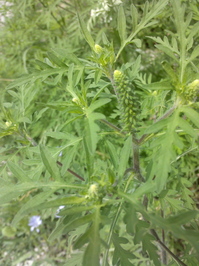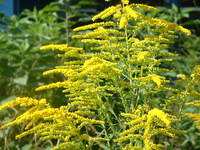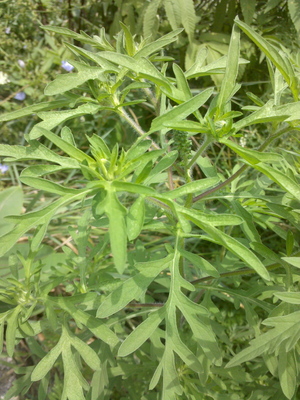Wildcrafting: Ragweed is stealthy, annoying - and debilitating for some people

Ragweed has a subtle flower, but it can produce huge quantities of irritating pollen.
Linda Diane Feldt | Contributor

Goldenrod gets the blame for causing allergic reactions, but it is a helpful plant with sticky pollen that is hard to spread.
Linda Diane Feldt | Contributor
A single common ragweed plant, Ambrosia artemisiifolia can release as much as a million grains of pollen each day. And therein lies the major problem. The secondary problem is identification. I’ve met hundreds of “ragweed sufferers” over the years who will point to goldenrod and claim an allergen to that plant, or who know they have trouble with ragweed but have no idea what it looks like. And then there are the happy gardeners who see this interesting plant and leave it be - it is kind of pretty, grows well and has interesting foliage. What harm could it do?
Even without an allergy, that much pollen in the air is irritating to the eyes, nose and throat. But for some people, ragweed pollen is potentially life threatening. Is there any reason to keep it around? I can’t think of one. The flowers are too small for the bees. It has no medicinal or nutritional value. It is a truly pesty weed. I’ll defend the dandelions, the plantain, chickweed and other weeds called “pests” but ragweed must go.
I’ll even defend goldenrod, so often accused of being a problem. Beautiful, edible, medicinal, and also prolific, the pollen of goldenrod is sticky. It doesn’t travel on its own. Watch the bees feeding on the goldenrod come away loaded with sticky pollen. Unlike ragweed, you have to go to it to be involved.
Ragweed pollen finds you where you live and play. It attaches to your clothes. It is in the hair of dogs and cats. You will breathe it in and it will float into your eyes and lungs. There is no escaping from the ragweed, except inside in an air-conditioned space free of contaminated clothing, pets and friends.

The ragweed leaf is deeply cut and stands out in most gardens. At this time of year it is commonly 1-3 feet high.
Linda Diane Feldt | Contributor
It is a community service to go outside, find the ragweed around your home or business (it grows readily in an urban setting) and pull it out. Do it this week, because the tiny almost invisible flowers are just starting to bloom, and that’s where the pollen comes from. Hold onto the base of the plant, give a good tug, and it will likely come right out. The city compost is hot enough to destroy the seeds and its ability to reproduce; your home compost may not be. If you know you’re allergic use caution and ask a friend to pull it out for you. Although it is the pollen that is the problem, you might want to use gloves to be even safer.
Linda Diane Feldt is a local Holistic Health Practitioner, writer and teacher. You can follow her on twitter, visit her web site, or contact her directly ldfeldt(at)holisticwisdom.org Linda Diane offers a free monthly class on herbology and wildcrafting through the People’s Food Coop. The topic this Thursday is teaching kids about foraging and wildcrafting.


Comments
Rork Kuick
Wed, Jul 21, 2010 : 1:55 p.m.
I notice great ragweed allot too (Ambrosia trifida), perhaps cause it is just so big.
AlphaAlpha
Wed, Jul 21, 2010 : 5:57 a.m.
Hi Linda - Thanks for the continuing good articles. Thistle is beginning to bloom; could you possible write a bit about how we might best take advantage of this excellent plant? Tea, made from fresh plants, for example? Thanks.